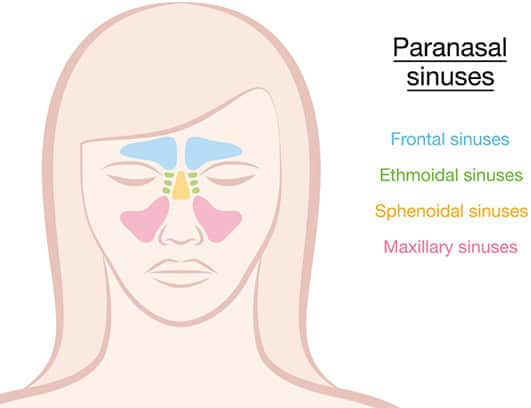The sinuses are air-filled cavities in the skull. There are four sets of sinuses.
- The frontal sinuses lie above the eye and in front of the brain on each side.
- The ethmoid sinuses are a group of smaller air cells clustered between your eyes.
- The maxillary sinuses lie underneath each eye.
- The sphenoid sinuses lie in the center of your head, underneath the brain.

All of the sinuses have openings which drain to the inside of the nose. The maxillary sinuses are the first to form during human development in the womb. They are very small at birth and continue to grow throughout childhood. The ethmoid sinuses are also present at birth but small. The sphenoid and frontal sinuses are not visible on x-rays at birth but continue to grow into childhood. About 10% of the population lack a frontal sinus on one side and around 4% of the population do not have frontal sinuses.
Certain structures inside the nose are closely related to the sinuses. The internal side wall of the nasal cavity on each side has three sausage-shaped structures. These are called turbinates (inferior, middle and superior turbinates).
The turbinates are bony outgrowths which are lined by a thick mucous membrane. They act as “radiators” or the “HVAC” (heating/ventilation/air-conditioning) system for the nose with the purpose of warming, humidifying and filtering air for the lungs.
The turbinates have a very rich supply of blood vessels underneath the mucous membrane and this allows for heat to be transmitted to the nasally inhaled air. They are also coated with a thin, wet mucous coating which gives off water vapor and humidity to the nasally inhaled air. The mucous layer also traps foreign particles in the air (dust, pollen, mold spores, smoke particles, air pollution, carpet fibers, insects, etc.) and thus filters the air before it gets to the lungs.
The turbinates are necessary for normal nasal function, but they can malfunction or become problematic in certain conditions (colds, allergy flares, sinus infections, chemical irritation, congenital enlargement). During these conditions, the turbinates are swollen and cause congestion and obstructed nasal breathing or perhaps even blockage of the sinus drainage pathways.
Medications designed to control the swelling may be useful in reversing the process temporarily. Sometimes the turbinates are irreversibly swollen and procedures are required to reduce their size and thereby improve nasal breathing.
The nose is divided into two chambers by the nasal septum. The septum is made of bone and cartilage and covered by mucosa (the lining of the nose/sinuses and aerodigestive tract). Most people have some degree of “septal deviation.” The septum may be displaced to one side or the other. Occasionally it can deviate to either side in different locations. When there is a significant deviation, breathing through the nose becomes a challenge. Septal deviations are typically acquired through trauma or through birth and development. Correcting this with surgical approaches is possible.

The sinuses are lined with a moist mucous membrane similar in appearance to that on the inside of your mouth. This moist, pink mucous membrane is called respiratory mucosa. It is continually secreting mucous. The mucous is continuously “swept” out of the sinuses by microscopic hairs lining the mucosa. These tiny hairs also line the nasal passages and are called cilia.
In a typical, healthy nose clear mucous is produced in the nose and sinuses and is swept out of the sinuses through small drainage holes into the nasal passages. In the nose, the mucous gets transmitted by the cilia to the nasopharynx (the back of the nose, just above the throat). Here it is carried to the throat and swallowed.
This is the normal process and as long as the mucous is not overproduced or abnormally thick, we don’t notice the process of mucus clearance and swallowing.
During allergy flare-ups, colds, sinus infections, exposure to smoke or air pollution or in unusually dry environments (airplane, desert climate) the mucous becomes thick or overproduced. This interferes with the clearance from the sinuses and nose. In addition to the mucous being thick and difficult to clear, the cilia do not function normally during the conditions mentioned above. Patients with recurrent infections may have chronic inflammatory diseases that keep the passageways swollen or may have poorly shaped sinuses that do not allow the sinuses to drain properly. Therefore, the mucous can accumulate in the nose and sinuses, causing congestion and pressure and ultimately the mucous can become secondarily infected by bacteria.
The function of the sinuses remains largely unknown. Many theories exist on the reason we have sinuses. They include:
- Functioning as resonance chambers for speech
- Supplying conditioned air to diffuse with inhaled air in the nose
- To assist with the sense of smell
- To protect the brain (by acting as a “crumple zone” during blunt trauma to the face and forehead)
- To lighten the skull (hollow spaces in the skull instead of solid bone)
Call Benjamin Liess MD at (207) 415-4841 for more information or to schedule an appointment.